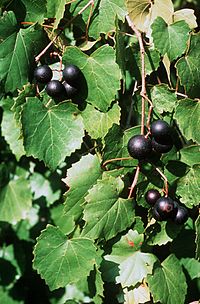
Photo from wikipedia
Within the EU, changes in policy and public sentiment have made it more urgent to consider the adoption of sustainable agricultural practices. Consequently, one of the EU's goals is to… Click to show full abstract
Within the EU, changes in policy and public sentiment have made it more urgent to consider the adoption of sustainable agricultural practices. Consequently, one of the EU's goals is to reduce pesticide use by 50 per cent by 2030, including in viticulture. One of the proposed approaches is to expand the use of disease resistant hybrid grape-cultivars (DRHGC), such as 'PIWI' grapes (German, Pilzwiderstandsfahige Rebsorten), and to introduce new DRHGCs. However, the characteristics of DRHGCs are different from those of Vitis vinifera, which makes it necessary to take measures and make changes in winemaking technology to maintain high wine quality. This paper examines the chemistry of wines made from DRHGC and discusses their impact on aroma and flavor profiles. It also reviews the main winemaking practices suggested to produce high-quality wines from DRHGCs. The chemistry of DRHGCs is different to wine produced from V. vinifera, which can lead to both challenges during winemaking and unusual flavor profiles. Although newer DRHGCs have been bred to avoid unexpected flavors, many DRHGCs are still rich in proteins and polysaccharides. This can make tannin extraction difficult and produce wines with little astringency. In addition to this, new or alternative winemaking techniques such as thermovinification and the use of alternative yeast strains (non-Saccharomyces) can be used to produce wines from DRHGCs that are acceptable to consumers.
Journal Title: Comprehensive reviews in food science and food safety
Year Published: 2023
Link to full text (if available)
Share on Social Media: Sign Up to like & get
recommendations!